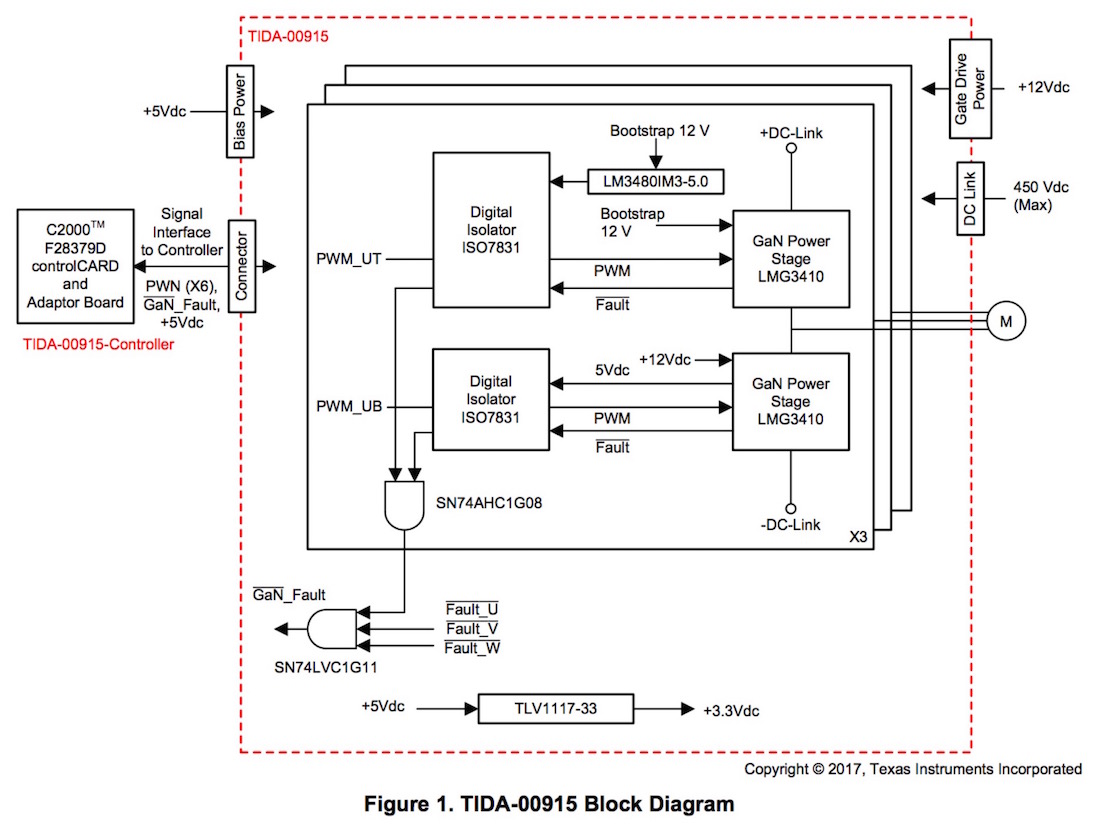Texas Instruments has released a new power stage reference design, TIDA-00915, that claims up to 99% efficiency.


Here are some pertinent specs for the LMG3410, which was released last year:
- Integrated 70-mΩ, 600-V GaN transistor and driver
- Single package
- Up to 1 MHz steady-state operation
- 20-ns typical propagation delay
- Operates from a single unregulated 12-V supply
- Externally-adjustable drive strength for switching performance and EMI control (supports 25 to 100 V/ns)
- Integrated DC-DC converter for negative drive voltage
- UVLO protection, over-current protection, over-temperature protection
- High edge-rate tolerance
It features the fast switching ability of GaN (more on that below)—less than 25 ns.
What's Gallium Nitride (GaN)?
One of the noteworthy things about this reference design from TI is that it utilizes gallium nitride. GaN is a semiconductor material that is—at least in theory—giving silicon a run for its money.GaN is an extremely hard substance with a Wurtzite crystalline structure. Its wide band gap of 3.4 eV (compared to silicon's 1.12 eV band gap) gives it special properties that have piqued the interest of semiconductor developers. It's prized for its performance in high-power and high-temperature applications, but it's gained the most attention for its efficiency in power conversion and high switching speeds.

A gallium nitride crystal
Its applications range from optoelectronics to photovoltaics to aerospace—and it's also the substrate used in violet laser diodes, which are used in Blu-ray discs. GaN has even been used as a material for nanotubes for use in nanotech.
Over the past decade, GaN has gained traction among major component manufacturers as a semiconducting material used in transistors. Besides TI, several other companies, including Dialog Semiconductor, NXP, and ON Semiconductor, have also entered the GaN realm. Companies are also increasingly offering eGaN ("enhancement-mode") products that grow a thin layer of GaN on a silicon wafer.
Leading the charge is Alex Lidow of EPF (Efficient Power Conversion), who is something of a GaN evangelical. In an article published by IEEE Xplore this March, Lidow claims that GaN has proved itself to allow superior switching and efficiency. He says that GaN has been responsible for the boom in many of the most popular technologies today, including LiDAR and wireless charging. According to Lidow, the final barrier protecting the silicon industry is a lack of confidence in GaN.

Representation of a GaN transistor. Image courtesy of Efficient Power Conversion
Texas Instruments, for their part, asserts that their GaN power module allows 5x faster switching compared to silicon FETs. They also boast that this optimized switch performance allows for less power loss.
99% Power Efficiency
The design reports 98% efficiency at 100kHz PWM, a setting they appear to recommend as it reportedly improves torque ripple with low-inductance motors.The big news, of course, is that it also reports 99% efficiency at 24 kHz PWM, with reduced heat sink size (allowing more space on a board for new features). That's awfully close to the physically impossible 100% efficiency. In fact, in their announcement of the reference design, they actually say "greater than 99 percent efficiency".

Converter efficiency, given PWM rate. Image courtesy of Texas Instruments
Clearly, TI did testing to come to these impressive figures but it would still be interesting to see this design in action.
Check out the reference design for yourself here for more information. Let us know your experiences with the TIDA-00915 or any of TI's GaN reference designs in the comments below.







No comments:
Post a Comment